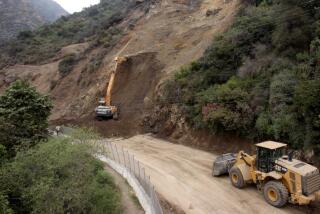No Quick Cure for Jetliner Noise, FAA Official Tells Topanga Residents
- Share via
As a passing jetliner partially drowned him out, a Federal Aviation Administration official warned Topanga Canyon residents not to expect a quick end to jet noise.
It is premature to tell whether the upcoming overhaul of Los Angeles-area air traffic routes will solve the problem of low-flying jets over the 2,000-home canyon, said Richard A. Cox, head of the FAA’s Los Angeles Radar Approach Control Center.
Cox and three other FAA officials met with the Topanga Town Council on Monday night to discuss jet noise complaints. The meeting came a few hours after the FAA announced plans to redraw Los Angeles-area flight paths used by incoming airliners.
One of the currently used incoming routes has been blamed by officials for the canyon noise. They say arriving planes force some aircraft taking off from Los Angeles International Airport to fly at a low altitude over Topanga Canyon.
But Cox said that air traffic planners who are drawing up the new arrival routes to improve air safety have not yet settled on new departure routes.
“This whole process is in an early stage,” Cox told 125 residents meeting at the hilltop community hall that is the meeting place of the Topanga Town Council, a non-governmental community group that advises the county on local issues. “If the restructuring of arrival routes comes to pass, the departures could be higher. But it’s too early to tell.”
That was unsettling news to homeowners from the canyon and from nearby Calabasas who have complained of the noise from many of the 70 commercial airliners that take off daily from LAX on a northbound route called the “Gorman Five.”
The complaints have prompted a variety of responses from the FAA. In recent months, officials went from denying there is a noise problem to promising quick relief by having jets fly higher over the canyon. Then they announced that relief will come in about 18 months when routes are restructured.
Cox told homeowners Monday, however, that the 18-month estimate might be “pretty optimistic” because “it’s too early to tell what impact” the rerouting plan will have.
Air traffic controllers have begun requiring planes departing LAX to adhere to guidelines that call for them to be 12 miles out over the ocean before turning north over Topanga Canyon, he said. That puts the planes at a higher altitude when they pass over the canyon than when they take a shortcut and turn sooner.
A review of Gorman Five departures in February indicated that about 25% of the planes were turning early, said air traffic controller Fran Vandiver, one of the FAA representatives at the meeting.
A 12-mile turn will put northbound jets at about 11,000 feet by the time they cross over Topanga Canyon. But they have to be kept lower than 9,000 feet when arriving southbound planes are in the vicinity.
Officials paid no heed to the jetliner that roared overhead 25 minutes after Monday’s 8 p.m. meeting began. That plane was followed by several others that sounded higher and quieter.
The announced changes in arriving flight routes include the shifting of southbound air traffic westward over the Pacific Ocean and away from the San Fernando Valley area, said H. C. McClure, director of the FAA’s four-state Western-Pacific region.
LAX-bound planes would pass near Point Mugu, head in over Santa Monica and make a 360-degree turn before landing at Los Angeles International Airport.
That change would eliminate a congested air traffic area at Fillmore, north of the Valley. That area is near the Gorman Five departure path that funnels northbound jets from LAX over Topanga Canyon, Calabasas and West San Fernando Valley.
FAA officials said the rerouting would be part of a three-phase modernization of the FAA’s operations in the Los Angeles area. They said it would take at least 18 months to train controllers and make sure that the new routes work by testing them on computers before actually implementing them.
More to Read
Sign up for Essential California
The most important California stories and recommendations in your inbox every morning.
You may occasionally receive promotional content from the Los Angeles Times.














